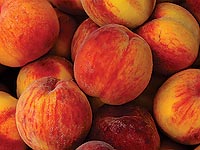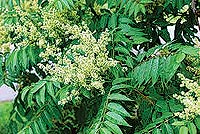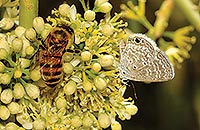 Native, invasive, exotic, introduced, established, non-native - what do we really mean when we classify living things with these terms? And what should you choose for your garden? Native, invasive, exotic, introduced, established, non-native - what do we really mean when we classify living things with these terms? And what should you choose for your garden?
Native or non-native? In short, a native plant is one which developed in the area in which it still lives, and this usually implies that it has deep and complex relationships with all the living and non-living elements of its environment, and that it is uniquely adapted to living in its environment. In Moab, this means they can handle drought and occasional floods, wind, heat, and sun with aplomb. These can be great choices for a beautiful xeriscaped yard, with the added benefit of providing habitat for native pollinators.
 Many non-native, exotic, plants are also good choices, and provide much-appreciated food, flowers, shade, and habitat without doing any harm. They tend to use more water than the desert denizens, but the payoff can be worth it - the sweet juicy flesh of a peach, for instance, is something you won’t find growing wild anywhere in these red rocks! Thousands of plant and animal species were introduced (brought here) intentionally and accidentally to US soil beginning when the first boats landed in 1620 and rats and dandelions disembarked along with the human passengers. Many of these species have since become established (living and reproducing independently) and are thriving in their not-so-new environments, sometimes causing on-going problems, and sometimes simply coexisting with whatever was there before. Many non-native, exotic, plants are also good choices, and provide much-appreciated food, flowers, shade, and habitat without doing any harm. They tend to use more water than the desert denizens, but the payoff can be worth it - the sweet juicy flesh of a peach, for instance, is something you won’t find growing wild anywhere in these red rocks! Thousands of plant and animal species were introduced (brought here) intentionally and accidentally to US soil beginning when the first boats landed in 1620 and rats and dandelions disembarked along with the human passengers. Many of these species have since become established (living and reproducing independently) and are thriving in their not-so-new environments, sometimes causing on-going problems, and sometimes simply coexisting with whatever was there before.
It is when an introduced, exotic species becomes invasive that trouble begins, and we absolutely want to avoid deliberately planting any of these in our soil! An invasive species is one that escapes, grows wild, and causes harm, be it environmental, economic, or to well-being. Tree of heaven (Ailanthus altissima) is a well-known local example. Introduced intentionally a few different times since the 18th century, it grows easily in difficult places, displaces native species, reproduces prolifically (up to 325,000 seeds a year!), and can be toxic to other plants and animals - including dogs. The state of Massachusetts has gone so far as to ban the importation, distribution, trade, or sale of Ailanthus altissima since 2009. Russian olive and tamarisk are two other common local plants with a similar story.
Choose wisely when you plant, and take a look first at some of our lovely native plants that know how to thrive in this environment. If picking an exotic species, make sure it’s not known to be invasive before you plant. There are some lovely ways to landscape with a mix of natives and non-natives that will bring you and your wild neighbors sustenance and joy for years.
 |